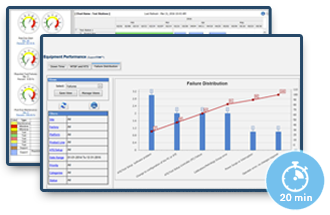

We’ve Been Building Resilient and Trustworthy Test Networks for Over 20 Years.
Operations supported by test equipment are one of the most costly asset-intensive environments in large manufacturing companies. The practices and tools we use to build our customers’ asset networks are proven by results: reducing equipment spend over 50% while decrease critical process cycle times by 25%.
The large hierarchical organizations that brought efficiency and effectiveness to the last industrial revolution are too slow for the pace of change today. Companies that continue to depending solely on these management structures will not survive today’s pace of change. It is the reason almost every company I know is in the midst of a “transformation” effort. No one, they tell me, wants to become the next Blockbuster Video.
Reorienting Networks From the Old Hierarchies
The networking capability in the old structures needs to be both strengthened and reoriented to be competitive. Some of these department structures were disparaged with terms like silos, chimneys or black holes. They were costly to communicate with and impossible to extract anything of value from. The speed of today’s marketplace has changed the situation from a nice opportunity to improve to an existential threat requiring action. These departments now need to think of themselves as knowledge hubs. Places where knowledge is generated, shared and then used in other networks to accelerate enterprise processes that drive time-to-market and bottom-line results.
Test organizations develop skills in testing or finding ways not to have to test. They share them within their test network and then collectively use them to help other networks, like cross-functional product teams, get products to market faster. They take time to share what’s working and what’s not within their “test network” to leverage into the processes that more directly produce enterprise value. They do this the same way offensive linemen in football work together and with their line coaches so when they are in the game, working with the entire offense, the team scores points.
What Makes a Test Network Trustworthy?
In another blog post, Are you Building a Foundation for Speed, I’ve focused mainly on building human trustworthiness. For a network or organization to be trustworthy, each component or “node” must be trustworthy – humans and the equipment and tools they use – as well as how they are organized. Test professionals are trustworthy by having practices like those written about in the previously referenced blog post. Here I’ll focus mostly on the trustworthiness of the tools and their organization as part of the larger network of people and tools.
Trustworthy Test Networks must be Resilient
Networks are made up of capabilities. They include humans as well as the tools and equipment they use. From a network language perspective, these capabilities are nodes in the network and sometimes those nodes are organized into clusters – for instance, functional teams like test or quality. For a node or cluster to be trustworthy we have to be able to anticipate how it will act with respect to what we care about, like getting products to market or meeting revenue and cost budgets. To be trustworthy, when the marketplace is changing quickly – and it is, the test organization must be able to reconfigure and adapt at the same pace as its environment so it can still act effectively. This quick reconfiguration is what makes it resilient.
Managing Resources as a Network
To manage resources as a network they have to be managed together, each resource in the context of all other resources and the outcomes the teams and the enterprise are after – like time-to-market or profitability. This means being able to anticipate resource conflicts as project schedules and priorities move later and earlier. The complexity and speed of today’s test operations make this impossible without the use of software tools to anticipate these conflicts and those tools must be integrated from both a data and workflow perspective. In Sente Takes a “Whole System” Approach” and I write about how we integrated our software from the start precisely because we were after significant improvement to speed and cost that are not possible with one-off, discreet solutions.
Your Network-of-Test-Capabilities Must Be Trustworthy Inside and Outside the Company
Suppliers must be able to respond quickly to the full array of their customer’s fast-changing requirements. To do this they must themselves be managing their environment with effective practices and cultural behaviors and those practices and cultural behaviors have to be coherent with yours otherwise, in fast-changing environments, trust breaks, costs increase, processes are slowed and results become non-competitive.
Knowing the Truth About Your Test Resources
The proliferation of spreadsheets and one-off software solutions, like asset databases or scheduling tools – effective before – makes it impossible to manage your resources as a “whole” since each of the resources is managed in separate, discreet, non-networked and sometimes non-networkable tools. These tools eliminate any possibility of knowing the truth about your test resources in the timeframe required for fast decision making. These tools make test networks rigid and weak instead or resilient and adaptive.
Sente’s tools are organized for managing resources like a network while having all of the capabilities for managing concerns historically managed in spreadsheets or one-off tools like:
- Asset Management
- Risk Management
- Performance Management
- Maintenance Management
- Schedule Management
- Calibration Management
- Knowledge Management
- Capacity Management
Trust and Truth Leads to Innovation, Speed and Competitive Advantages
An insight I heard from Jack Welch years ago, that trust leads to truth and when you have both you get speed, lead me down a path of inquiry that, combined with other learning and studying I’ve done lead to me naming our Culture Change Algorithm — something that we’ve been executing for over 20 years.
Read our various case studies and content on our website to see how we help our customers achieve their goals fast.
Request a Demo

See how Scireo aEAM Software drops asset and support costs by 50% while accelerating time-to-market 2X.
Relevant Content
Case Study: Aerospace Company Drives One Company Synergies
Like many aerospace companies, this one had many sites and different legacy cultures on each. See how they installed common resource management tools, increased utilization 3X and funded new programs.
Equipment Utilization Case Study: Space Company Leverages Assets
The hoarding culture was slowing this company down while impacting cost and quality. See how a journey to common processes and collaboration lead to a 50% reduction in assets as their business doubled.
Accelerated EAM: Leveraging Technology & Skill to Go Fast and Be Safe
Speed is the key to competitive advantage and speed is not possible without visibility to obstacles – but it is only an advantage if you can see things your competitors can’t and then know what to do about them. Seeing less known but nonetheless serious obstacles require technology and competence. Without them, you can’t go…
Are You Building a Foundation for Speed?
Every solution you install in your company should enable you to increase your speed and reduce cost, and minimally should “do no harm” in either area. Most solutions today fail this test and inadvertently reinforce old behaviors that add costs and delays because they aren’t designed to produce a foundation of trust. Our solutions are…
Notable Quotes
“Sente’s proprietary Test Resource Management™ solution delivers an integrated and holistic approach for test resource management with unique capabilities that allow large organizations in the aerospace and defense, semiconductors, and life sciences industries to manage and streamline the complexity of their test operations and to be more effective, competitive, and strategic. Frost and Sullivan Analyst








